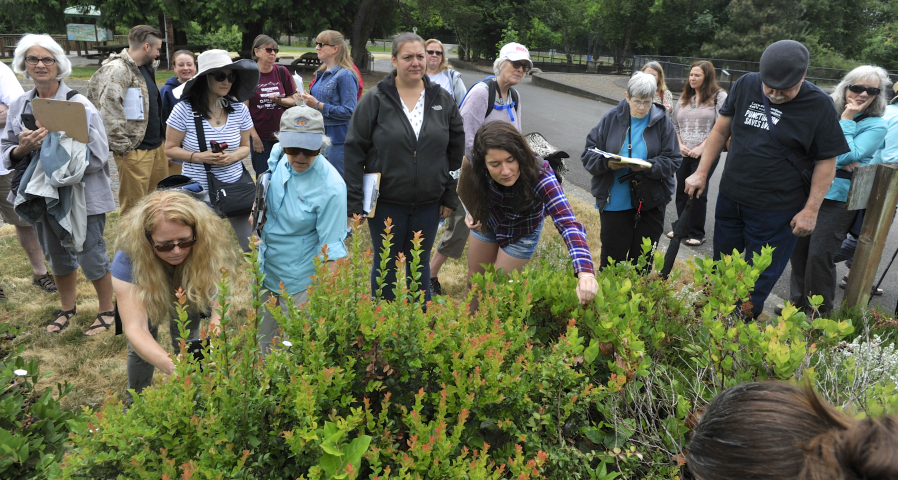Of the 80,000 edible plant species in the world, only four — rice, corn, wheat and potato — produce 50 percent of the typical human diet. Looking to add a few more plant species to her diet, Kate Webb nibbled on the leaf of a lamb’s-quarters plant and sampled salal berries growing on a bush on the Columbia Springs grounds.
“Personally, I don’t find dandelions particularly tasty, so I’m looking for alternatives,” Webb said.
The Portland woman was joined by about 40 other like-minded people Saturday morning at an Intro to Urban Foraging workshop at the nonprofit’s campus in east Vancouver.
When most people think of foraging, they think of searching for wild, edible plants in the woods. But the free bounty isn’t limited to the forest, and that was the point of Saturday’s workshop, said Erik Horngren, Columbia Springs volunteer manager.
“It’s things they could find anywhere,” Horngren said. “These are things you could find in your backyard or in the park.”
Columbia Springs volunteer Eve Hanlin, who works as a landscape designer and flower farmer, taught workshop participants about the edible weeds and plants growing in backyards across the county that are often discarded, such as the lamb’s-quarters, white clover and catsear.
Lamb’s-quarters, for example, was a food source for pioneers and continues to be grown and harvested as a grain in Africa, Asia and India. Here, however, people discard the leafy plant when weeding their yards and gardens.
“That’s a weed I’ll let grow,” Hanlin said.
Likewise, the flowers from white clover make a great addition to cookie recipes and catsear, which resembles a dandelion, can be added to stir fries, Hanlin said.
“Surprisingly, a lot of these things are more nutritional than the produce you’d buy at the grocery store,” she said.
Hanlin also offered some foraging safety tips — such as avoiding areas near busy roads where heavy metals can invade the plants and locations where pet waste may be found — and gave a primer on poisonous plants that could be mistaken for edible plants.
Nightshade, for example, has leaves and berries similar to those of tomato plants but neither the leaves nor berries are safe to eat. And poison hemlock — which, as the name suggests, is poisonous — looks similar to safe-to-eat wild carrots, Hanlin said.
Hanlin recommends anyone who is interested in urban foraging read at least three credible sources before consuming discovered foods.
After an hour-long presentation, participants took a walk on the Columbia Springs grounds, and Hanlin pointed out safe and not-so-safe plants, berries and trees.
Webb, of Portland, has done some foraging on her own, harvesting chamomile from her yard for tea and snacking on wild huckleberries, but she saw Saturday’s workshop as an opportunity to expand her knowledge of safe plants — and beef up her post-apocalyptic survival preparedness.
For mother and daughter Bret Kertz and Olivia Perry-Kertz, 6, the event served as a launching point for urban foraging. The Vancouver duo regularly walks the Burnt Bridge Creek Trail near their home and, lately, Olivia has been asking if she can eat plants and flowers they come across. Kertz plans to use Saturday’s workshop as the groundwork for summer foraging with her daughter.
“She’s really getting into it,” Kertz said. “She’s more excited about trying new things. This is awesome.”





